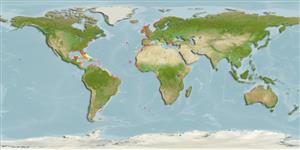Endeis spinosa (Montagu, 1808)
| Native range | All suitable habitat | Point map | Year 2050 |

|
| This map was computer-generated and has not yet been reviewed. |
| Endeis spinosa AquaMaps Data sources: GBIF OBIS |
Upload your photos
Google image |
No photo available for this species.No drawings available for Endeidae.
Google image |
No photo available for this species.
Classification / Names Common names | Synonyms | CoL | ITIS | WoRMS
Pycnogonida | Pantopoda | Endeidae
Environment: milieu / climate zone / depth range / distribution range Ecology
Benthopelagic; depth range 0 - 12 m (Ref. 256). Subtropical
Distribution Countries | FAO areas | Ecosystems | Occurrences | Introductions
Western Atlantic and the Mediterranean.
Length at first maturity / Size / Weight / Age
Maturity: Lm ? range ? - ? cm Max length : 0.3 cm BASL male/unsexed; (Ref. 276)
Short description Morphology
Length: Females, 0.4 cm; males smaller (Ref. 256); 3 mm body length; legs 15 mm long (Ref. 276). Body: Slender-cylindrical, with the lateral processes wide apart, each furnished with a dentiform projection at the tip. Cephalon: Frontal spines close together, the collar having sinus in the middle on the dorsal side. Chelifores and palps: absent. Abdomen: oblong-oval, truncate at the posterior end; armed with a short spine. Ocular tubercle: exactly in the middle of the cephalon, prominent, acuminate, the four eyes comparatively small, closer to the base of the tubercle. Proboscis: long and slender than the body, expanded in the middle. Ovigerous legs: male only, half the length of the body, with seven segments. Second segment: largest, the 5th segment larger than preceding or succeeding it, sharply curved; last segment triangular, with two short spines on the inner margin. Ambulatory legs: 3 times the length of the body, armed with scattered spines, unequal in length; 2nd coxal segment longer than taken together; femur twice as the coxal section and terminating outwards in a conical process, armed with two spines of different length. Tibia: 1 shorter. Tibia: as long as the femur. Tarsus: obliquely rounded. Propodus: four times longer than broad, terminating outwards in a sharp corner, inner margin furnished at the base with five spines, the two outmost placed side by side, terminal claw more than half the propodus. Auxiliary claws: less than half as the main claws. Body: translucent, with the intestine and its lateral expansions of a green color (Ref. 256). Proboscis: Detritus-gathering as a different source of food, lack chelifores, and capable of considerable movement at the region of the 'soft collar'; a number of bifid setae scattered on the surface and sometimes groups of tactile or chemosensory spines abundant around the mouths of this detritus-feeding forms. The mouth at the tip of the proboscis: triradiate structure; three lip-lobes and carry a number of setae (Ref. 12)
Feeding on hosts: Debris at the base of Antennularia(Ref. 234). Coastal to slope (Ref. 19). Planktonic (Ref. 91956). Epibiotic (Ref. 116112). Larva develops attached to the hydranth of Obelia sp. (Ref. 121217). Chemically attracted to various hyrdoid species (Ref. 121217). Reported to be exclusively detritivorous (Ref. 121217).
Life cycle and mating behavior Maturity | Reproduction | Spawning | Eggs | Fecundity | Larvae
Life cycle: release a number of eggs at each mating; represents the contents of a single femur (Ref. Ref. 12). Development site of larval associations: Obelia medusae and hydroids (Ref. 206).
Main reference
References | Coordinator | Collaborators
de Kluijver, M.J. and S.S. Ingalsuo. 2005. (Ref. 256)
IUCN Red List Status (Ref. 130435)
CITES status (Ref. 108899)
Not Evaluated
CMS (Ref. 116361)
Not Evaluated
Threat to humans
Human uses
| FishSource |
Tools
More information
Internet sources
BHL | BOLD Systems | CISTI | DiscoverLife | FAO(Publication : search) | Fishipedia | GenBank (genome, nucleotide) | GloBI | Gomexsi | Google Books | Google Scholar | Google | PubMed | Tree of Life | Wikipedia (Go, Search) | Zoological Record
Estimates based on models
Preferred temperature
(Ref. 115969): 8 - 27.9, mean 20.2 (based on 1604 cells).
Price category
(Ref. 80766):
Unknown.


